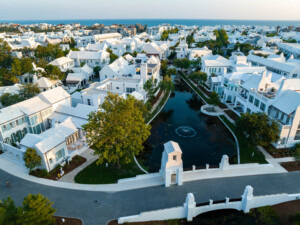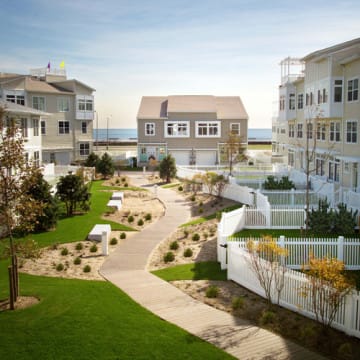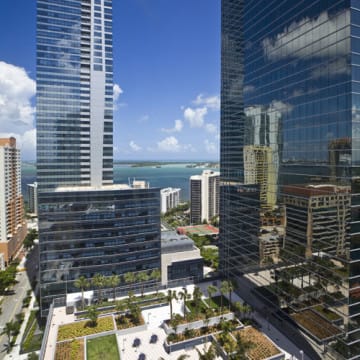Alys Beach
Along Florida’s shimmering Emerald Coast, Alys Beach is a unique architectural and planning creation—a pure-white realm of homes and businesses that emerge from the sand like seashells, naturally and effortlessly. Because the resort is located in a high-risk coastal setting, designers DPZ CoDesign and developers EBSCO Industries knew this community would need careful design to withstand the Gulf of Mexico’s hurricane winds and storm surge. They combined coastal vernacular architecture influences from Bermuda and Antigua Guatemala with the protection of the Insurance Institute for Business and Home Safety’s FORTIFIED Home program to create the first FORTIFIED for Safer Living® community in the world. Coupled with an extensive network of green infrastructure and preserved natural dunes and wetlands, Alys Beach is well prepared for coastal storms, and has the property values to prove the business case.
Context
Alys Beach began design in 2003 as a labor of love by EBSCO’s cofounder, Elton Bryson Stephens, Sr., who bought the land in the late 1970s and named the future community after his wife, Alys. The area, known locally as 30A after the scenic highway running through it, and its beach resort communities are a treasured destination across the Southeast, with increasing recognition in other regions. Most homes in Alys Beach started as vacation homes, but post-COVID, many homeowners took up year-round residence.
Alys Beach stands out for its award-winning New Urbanist design, created by some of the founders of New Urbanism itself—DPZ CoDesign, the firm established by Andres Duany and Elizabeth Plater-Zyberk, in collaboration with and carefully maintained by town architects Marieanne Khoury-Vogt and Erik Vogt, who have added their own flair and influences from Moorish, Greek, and other vernaculars.
As Galina Tachieva, managing partner at DPZ explains, Alys Beach was informed by the earlier, nearby DPZ projects of Seaside (already famous by the time) and Rosemary Beach, and can be understood as a third generation of sustainable and resilient developments that prioritize compact, walkable, pedestrian-scaled communities filled with open spaces and public gathering areas in the style of older, pre-automobile cities around the world. “The compactness of these communities is the number one condition for being environmentally responsible, because then you can leave nature alone,” she notes.
Storm resilience was also an obvious necessity, given the location and the community’s origins. “The Stephens family was committed to this as a legacy project and was not going to take shortcuts, and understood the need to invest on the front end,” according to Khoury-Vogt. Developer and designer visions aligned, and when DPZ was brought in, “it became really important that sustainability was considered on all aspects of the project from the horizontal infrastructure to the vertical infrastructure.”
As described by Allan Barnes, president of Apex Engineering Group, every structure is designed to withstand wind speeds over 160 miles per hour, or a Category 5 hurricane and an F3 tornado. Homes near the water are built to the ASCE/SEI Standard 24-14, Flood Resistant Design and Construction, and the guidelines of FEMA P-550, Recommended Residential Construction for Coastal Areas: Building on Strong and Safe Foundations, using deep pile foundations and site walls that can endure wave impacts, scour, and erosion. All told, the site is prepared to experience “extreme storm event-related erosion and scour” and “the dynamic wave set-up and surge elevation of a 100-year storm event.”
Climate Resilience and Sustainability Strategies
Alys Beach uses a combination of green infrastructure/site strategies and building strategies to achieve a resilient design that responds to its main risks of hurricane winds and extreme heat, and in extraordinary cases, storm surge.

Grade elevation and access
“We’re lucky here that we have a natural elevation that’s about 30 feet above the water, so we’re relatively inoculated against floods,” says Khoury-Vogt.
Preserved natural features
The master plan preserved the site’s original coastal dunes as the first line of defense, as well as 20 acres of existing wetlands on the opposite, inland end. The community regularly replenishes these dunes to ensure they remain functional for aesthetics and protection.
Green infrastructure and landscape features, and natural drainage system
In addition to these preserved natural features, designed green infrastructure permeates the entire site. All pavement is permeable, and the underground stormwater management system treats all on-site runoff, preserving local water quality and reducing maintenance. The design carefully spread an interconnected collection of smaller detention and retention strategies throughout, from small ponds and bioswales to vegetative buffers and rain gardens.
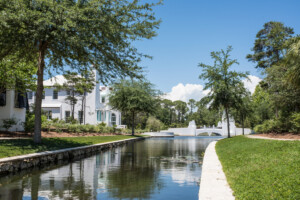
This design precludes the need for large detention ponds and creates a natural drainage system, mimicking the site’s predevelopment hydrological pathways, allowing storm and floodwater to move in and out much as it would naturally. The main streets are perpendicular to the beach, preserving all sight lines and providing storm surge a safe way to drain out of the community.
All homes are required to manage their stormwater discharge on site before it enters the community stormwater system, reducing its burden and the likelihood of flooding in Alys Beach and nearby. Only native plants, shrubs, and trees are used, which are suited to the stormy region and require far less irrigation and maintenance than conventional lawns.
Wind-resistant construction
The site’s need for storm resilience led to selection of the FORTIFIED for Safer Living® program, which every structure in the community is required to build to. The program builds on decades of IBHS research on wind vulnerabilities and exceeds the already-strict Florida and South Florida building codes, but wasn’t far out of reach based on the initial design vision.
“One key decision that was made early on for the architecture at Alys were shallow eaves, a huge plus in terms of the potential wind uplift, and the use of concrete tiles on the roof and a five-part system on top to weigh it down. Between that, the impact-resistant doors and windows, and the reinforced masonry block being the essential building block for Alys, we were 90 percent there in terms of adhering to those standards,” notes Khoury-Vogt.
The system effectively reduces the potential for wind damage by tightly fastening the entire building structure—foundations to walls to roofs—together to provide a continuous path for wind forces to follow, eventually transferring safely into the ground.
Impact-resistant, hardened materials
Hardened materials, such as concrete masonry units or cast-in-place concrete walls and concrete roof tiles, play a huge role (though all that concrete does increase the project’s embodied carbon). Khoury-Vogt says, “You can shoot a two-by-four at 150 miles an hour and you’re not going to penetrate your building envelope.”
Cool surfaces and heat-prepared exterior
The all-white coating on every structure reflects solar heat, keeping building interiors and the neighborhood cooler while evoking traditional settlements in hot places, such as Santorini or Tangier. The masonry construction also has high thermal mass, helping it absorb heat and keep indoor temperatures down.
Strategic building orientation and density
Importantly, in addition to concentrating buildings on the site to preserve natural features, Tachieva says, “the streets are perpendicular to the beach, which invites natural breezes up along every street and deep into the site,” keeping the entire community cooler. “This was a technique not used before Seaside, and later Rosemary Beach and Alys Beach—it was either townhouses or concrete towers and slabs parallel to the beach, to have the most views, but blocking everyone in the back.”
Streets run perpendicular to the water throughout the community, allowing natural breezes to circulate, permitting stormwater to drain out naturally, and preserving Gulf Coast views for all residents. Courtesy of Alys Beach.
Thermal comfort is paramount, and the aesthetics are inseparable from climate-smart design. For example, DPZ brought the patio house style from Antigua Guatemala as the basic home typology to mass the home around lot edges, creating beautiful and “very occupiable” internal courtyards, as Erik Vogt describes.
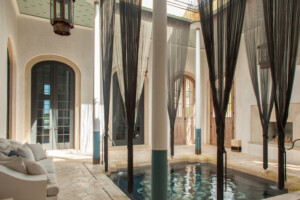
These are shaded but ventilated, and protected from storm winds and waves by reinforced walls. Common versions of these courtyards are also found at the center of many blocks. The patio or courtyard design is more common outside the United States, but Vogt says residents “. . . have really grown to love it. Now that’s become the most important part of the design for most of our clients.”
Low-carbon design
Though it does so quietly, Alys Beach has also emphasized low-carbon design. Vehicle parking is minimal and concentrated at the edges of the development, and extensive trails, smaller buildings, narrower street widths, and public greens make walking the most pleasant option. As Tachieva notes, this approach built on the early success of Seaside, where residents used their cars six to eight times per week, compared to six to eight times per day in nearby conventional developments. The nearly car-free environment not only supports the resort feel, but also reduces vehicle heat, transportation carbon emissions, and air pollution.
Buildings are tightly insulated and carefully ventilated, and use low-E windows. Designers also took the important step of sealing and insulating the attic, reducing heat gain. The white roofs also reduce energy consumption for air conditioning significantly.
Some homes even have solar panels and geothermal heating and cooling systems installed that further reduce carbon emissions.
As Vogt puts it, “What’s grown in importance, as much as the resiliency of construction, is the resource efficiency over the course of Alys’s lifetime, as the public’s understanding of climate change has grown. People appreciate that now almost as much as the durability.”
Value Proposition
Enhanced property value
First and foremost, Alys Beach has achieved some of the highest property values and sales prices in the state. Tachieva explains, “Per square foot, they are close to Manhattan prices, which is quite unusual for lots which are 20 to 24 feet wide by 60 feet long. These are multimillion dollar houses.”
Tess Howard, vice president of community and development planning at Alys Beach, agrees, and credits the FORTIFIED certification as helping secure the premiums needed: “Building in the FORTIFIED standard and the additional certifications helped to establish that level of quality so that we could demand the prices necessary to make the project come to fruition.”
Marketing advantage
The peace of mind provided by the exacting standards is also critical for boosting marketing and sales, and Howard explains that Alys Beach attributes its steady sales prices and volume in part to the quality of construction and FORTIFIED standard, and their ability to assure owners that their sizable investment will be protected.
Though the aesthetics and lifestyle attractions are top of mind for potential buyers, according to Diana Lane, director of public relations at Alys Beach, buyers’ interest and confidence grows after learning they won’t suddenly need to rush to board up their homes before a storm thanks to the property’s resilience features.
Reduced insurance premiums
Alys Beach’s design has also secured owners lower insurance premiums, an outcome that shouldn’t be underestimated given the increasing insurance crisis in Florida and other high-risk areas. “The insurance market for condos, is really, really intense,” says Howard. “The good thing is you know all of our condos are developed really responsibly, so when we are getting those milestone inspection reports and reserve studies done, we are faring well on the contributions recommended.”
However, she and Khoury-Vogt note insurance premiums have still increased tremendously and believe they should be lower, given Alys’s performance against storms.
Avoided losses
Alys Beach should also see far greater avoided losses and lower repair and replacement costs. Alys’s designers intended it to last for centuries, and that means avoiding the unsustainably expensive and disruptive cycle of destruction and rebuilding that has come to define life in many coastal communities.
Lessons Learned
- Consistency is key. To maintain community protection and its reputation for safety, each and every building needs to meet the high standards it relies on. The town architect, onsite general contractor, and approved builders are key to carrying forward both the strong design vision and excellence in resilience.
- A good pilot can make the business case. Though being an early adopter comes with challenges, Alys Beach’s success as the world’s first FORTIFIED-certified community showed the value of that program locally and built an attractive set of returns for other developers to take note.
- Resilience and aesthetics work better together. Many who work on Alys feel that the design lent itself well to a resilient product, while serving as a major value add. The all-white look is iconic, the vernacular architecture is dreamy but functional, the masonry is durable and lends a premium feel, and the courtyards and green infrastructure add extensive amenities and provide climate benefits.
